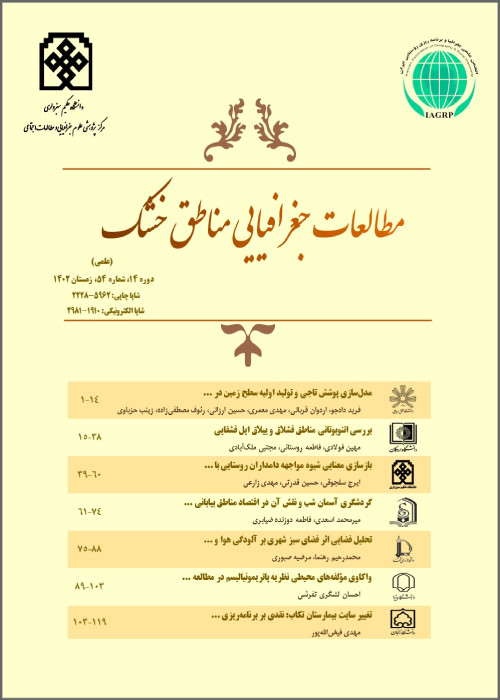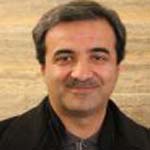Application of Satellite Images and GIS in the Feasibility of the Use of Solar Energy for Providing Lighting Systems (Case Study: Zanjan - Tabriz Highway)
Author(s):
Abstract:
Introduction
The human need for energy is continually increasing and the limited sources of fossil energy are reducing. The indiscriminate use of fossil fuels pollute the environment and threaten life on the earth. Besides, because of difficult terrain, unfavourable topographical conditions and inaccessibility of some mountainous roads to national electricity network or high costs of these systemss implementation, the solar energy as a renewable and free energy is considered the most important replacement for fossil fuels. The aim of this research is study of GIS and remote sensing techniques to calculation of net solar radiation reached to the earths surface (Rn) and zoning radiation in the studied area and determine the rate and intensity of the affecting factors, including the height, slope and slope aspect.The studied area included area of 220km of Zanjan-Tabriz Highway with geographic coordinates is beginning of 36º 39′ N latitudes and 48º 26′ E longitudes to 46º 50′ N latitudes and 37º 36′ E longitudes.
Materials And Methods
In this study, satellite Landsat 8's data for six months (May to October 2013), DEM images for this area with a spatial resolution of 30 meters and also ENVI5.1, ERDAS IMAGINE2011 and ArcGIS10.1 softwares, for preparation of images, calculations, spatial and temporal analysises and geting output of results have been used.In this investigation, the SEBAL algorithm was used to calculate the net solar radiation reaching to the earths surface. This algorithm formed of 25 models which calculate the evapotranspiration (ET) and other necessary factors of the energy balance equation. In the SEBAL algorithm the data of satellite images of visible, near infrared and thermal wavelengths is used for estimation of net radiation energy, soil heat flux, sensible heat flux and the latent heat flux for every pixel in images.
Results And Discussion
Results of this investigation can be summarized as follows:- The topography of studied area has variable height; it is beginning of 1103 meters up to 2083 meters. Due to this variety of topography, the area has variable net surface radiation.- In this method, the distribution of radiation is almost the same for all months and with create a 200 meter buffer around the road the distribution of radiation changes from 111 to 714 w/m2.
- The results show that in SEBAL algorithm, the correlation of radiation is 0.0916% with slope, 0.2794%with slope aspect, and 0.0137% with height. the used SEBAL algorithm in this study is flat model and is not mountain model. In SEBAL flat model the slope and slope aspect factors are important for calculation of net solar radiation reached to the earth's surface, but height factor is not effective so the least amount of correlation is related to height.
-The slope aspect is the most important factor in determination of the amount of received radiation energy. So that the South slope and slopes face sun in all study range received the most radiation and in northern and behind of sun slopes is reverse.
Conclusion
The studied area has different surface net radiation because of various topography. The distribution of radiation is almost the same for six months (May to October). The SEBAL algorithm has the highest correlation with slope aspect and the lowest correlation with height. The South slope and slopes face sun in all studied range received the most radiation. The amount of obtained radiation for the whole months is in the range of 111 to 714 W/m2 and also Photovoltaic cells are sensitive to solar radiation and receive it from radiation threshold to 1000 w/m2. So it can be concluded that the solar radiation in this area in the six months of study has the potential for performance of solar photovoltaic projects.Keywords:
Language:
Persian
Published:
Arid regions Geographic Studies, Volume:6 Issue: 21, 2015
Pages:
105 to 124
magiran.com/p1526882
دانلود و مطالعه متن این مقاله با یکی از روشهای زیر امکان پذیر است:
اشتراک شخصی
با عضویت و پرداخت آنلاین حق اشتراک یکساله به مبلغ 1,390,000ريال میتوانید 70 عنوان مطلب دانلود کنید!
اشتراک سازمانی
به کتابخانه دانشگاه یا محل کار خود پیشنهاد کنید تا اشتراک سازمانی این پایگاه را برای دسترسی نامحدود همه کاربران به متن مطالب تهیه نمایند!
توجه!
- حق عضویت دریافتی صرف حمایت از نشریات عضو و نگهداری، تکمیل و توسعه مگیران میشود.
- پرداخت حق اشتراک و دانلود مقالات اجازه بازنشر آن در سایر رسانههای چاپی و دیجیتال را به کاربر نمیدهد.
In order to view content subscription is required
Personal subscription
Subscribe magiran.com for 70 € euros via PayPal and download 70 articles during a year.
Organization subscription
Please contact us to subscribe your university or library for unlimited access!



